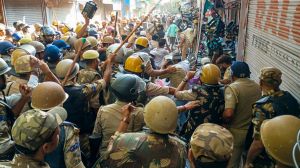The CPI(M)’s discovery of Bharat
Eleven freedom fighters, including INA’s Lakshmi Sehgal, sat on the dais at the Talkatora Stadium and they were honoured with garlands ...

Eleven freedom fighters, including INA’s Lakshmi Sehgal, sat on the dais at the Talkatora Stadium and they were honoured with garlands and bouquets at the start of the CPI(M)’s 18th Congress being held in Delhi. Party leader Prakash Karat, tipped to replace Harkishen Singh Surjeet as general secretary, made a point of celebrating the ‘‘freedom fighters’’. Criticised over the years for opposing the Quit India Movement and for their ‘‘extra-territorial’’ loyalties, the CPI(M) has, in the last 10 years, tried to link itself to the national movement. And this time, this thrust was much more visible.
This time, the CPI(M) talked about national sovereignty, national security and national honour much more than in the past. The draft political resolution emphasises ‘‘national sovereignty’’—both for the economy and against ‘‘imperialism’’. The CPM has expressed the hope that an increasing number of people will recognise the Left ‘‘as defender of the country’s interests’’.
Interestingly, while this Congress has been in session, Lok Sabha Speaker Somnath Chatterjee refused to attend the Commonwealth Conference in Sydney because he would be frisked and put through a body search—something he found not only personally humiliating but an insult to the Parliament of India, which he represents.
Another striking aspect of the 18th Congress is the party’s acknowledgement of the importance of caste. Since the implementation of Mandal, there has been much soul search that caste cannot be subsumed into ‘‘class’’, and this time, this idea was further stressed.
While the CPI(M) remains opposed to using caste as a tool of mobilisation—and is critical of caste-based parties—it feels that ‘‘the caste system contains both social oppression and class exploitation’’, and that ‘‘Dalits suffer from both types of exploitation in the worst form’’.
Since the days of Mandal, there has been an erosion in its base among Dalits who have gravitated to the Maoists and radical Left groups, besides the BSP. But now the CPI(M) wants to give a platform to the Dalits, adivasis and the most backward castes. It has been successful in rallying Dalits to its side in a state like Tamil Nadu, but this is not the case in the Hindi heartland where it now wants to make inroads. Yet the CPM’s leadership has traditionally been upper caste. In its 41-year history, it has never had a Dalit or a Muslim or a woman as a member of the politburo. None of these trends, consciousness about caste or a grab at nationalism are overnight developments. But they have become more visible at the apex level this time.
Most significant however, is the stamp of approval the CPM Congress seems set to give to the party’s decision to support of the UPA government. The CPM has come a long way from its anti-Congressism, which began to undergo a change in 1992 when at the 15th Congress, it declared itself equidistant from both bourgeois parties—the Congress and the BJP. Earlier, in 1989, HKS Surjeet and Jyoti Basu had prevailed upon the EMS Namboodiripad-led Kerala group to support the NF government even as the BJP was also supporting the VP Singh government from outside. At its 16th Congress in 1998, it moved away from the Third Front, which it had supported in 1996 under HD Deve Gowda, as it was faced with the challenge posed by the rise of the BJP. It decided to lend issue- based tactical support to the Congress to form a government, though such an attempt in 1999 was aborted.
At its 17th Congress in Hyderabad, it resolved to defeat the BJP alliance and form a secular government at the Centre, particularly after the widespread communal violence in Gujarat. Its tilt towards the Congress has been clear in the last decade. The message has now sunk right down to the rank and file, that the UPA must be supported.
Though the party has made it clear that it will continue to put pressure on the government to implement the CMP, and urged its cadre to launch mass struggles to do this, the upshot of its stand is that the CPI(M) is now willing to go along with the economic reforms package that the Congress carries. It does not plan to pull down the government. This should be sweet music to the Congress’ ears.
Many had feared that the Left might pull the plug before the 2006 elections in West Bengal and Kerala. As things stand, the Left Front does not have to worry in either of the states. In West Bengal, the Congress does not stand a chance and in Kerala it is hopelessly divided. It might have been a different story, had the Congress been on the upswing.
Its stand towards the Congress shows that the CPI(M)’s fight against communalism and its determination to keeping the BJP out at all costs remains its number one priority. Surjeet made it clear on day one that the Sangh Parivar was ‘Enemy Number One’ and the CPI(M) considered the Congress as ‘‘a secular party’’ whose role and relevance to safeguard secularism had tipped the scales in its favour. The other goals of the party outlined by the 18th party congress will play second fiddle to this primary objective.
Though its membership has hardly grown in recent years, it is a more pragmatic, more buoyant party in tune with the ground realities, conscious of its clout in keeping the UPA government in the saddle, and hoping to take-off in the country’s heartland.





- 01
- 02
- 03
- 04
- 05


























